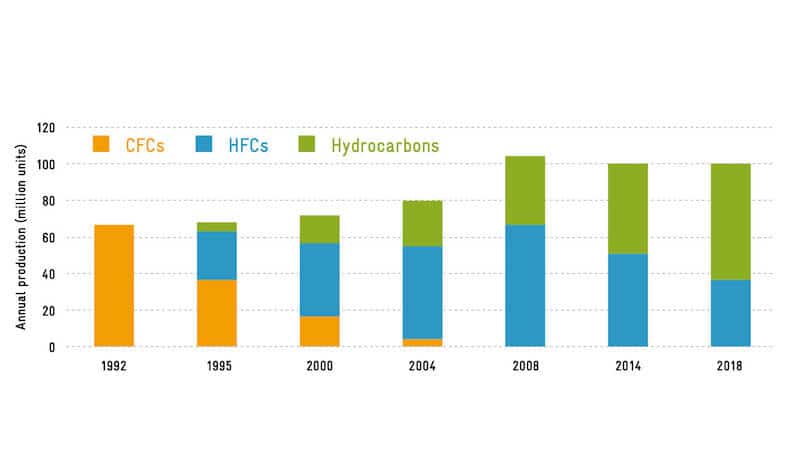
Considering the fridge unit is designed to keep food stuff cool, it isn’t hugely inefficient (at any given time) in terms of electricity usage. In fact, there are many interesting facts about refrigerators that might surprise you.
The problem is, the system must run at all times and that’s when usage starts to mount up.
This equates to approximately 10% of your total household’s energy consumption, and considering nearly 99% of homes have a fridge in the US, this energy use piles up.

Of course, there are other issues such as greenhouse gases and their effect on the o-zone, and although there are still issues, progress has been made on this front… such as the United States legalizing hydrocarbon gases like propane and isobutane that are friendlier to the environment.
Greenpeace’s contribution using environmentally friendly hydrocarbon gases

However, in this guide we look at ways of maintaining your existing refrigerator while making it run more efficiently. You can do your part until the time comes to get a new one, hopefully one that has less impact on the environment or possibly a freezerless refrigerator that uses less power.
There are six things that you can do to improve the efficiency of your fridge. These include making room for air circulation, cleaning the condenser coils, defrosting the freezer, changing the seal and storing food after it has cooled down. All of these tips will reduce the energy consumption.
“With decades of guaranteed infield experience as an energy efficiency consultant, I can tell you, optimizing your refrigerator isn’t as complex as it seems. First, it’s important to ensure the refrigerator is set to the correct temperature: not too cold, but cold enough to keep food fresh. Regular defrosting and avoiding over-stuffing can substantially improve energy efficiency. Trust me; these simple adjustments can make a world of difference for your energy bill.”
Radley Donovan , Energy Efficiency Consultant
Make Room For Air Circulation
This is one recommendation everyone can do. Any machine needs air circulation to function more efficiently, otherwise it has to work harder which uses up more energy and can stunt its life expectancy. This is especially important when considering multiple refrigerators on the same circuit, as proper air circulation can help prevent overloading.
You want the AIQ (Air Index Quality) to be below 150 and below 100 if you have health concerns.
Allow a few inches between your walls and the fridge so air can flow freely – job done!
Clean Condenser Coils
The condenser coils are typically located at the back of your fridge and are fantastic dust collectors. This dust acts as a layer of insulation and therefore retains heat within the coil which ultimately affects the cooling efficiency.
Be sure to unplug the fridge unit to avoid potential electrocution and brush away any dust.
This cleaning process can improve efficiency up to a whopping 25%, reducing your energy bill and helping the environment. You can also use a water filter vacuum cleaner to sterilize the area after cleaning up. It’s worth noting that even when not in use, appliances can consume standby power, so keeping them clean and efficient is crucial to a whopping 25%, reducing your energy bill and helping the environment. You can also use a water filter vacuum cleaner to sterilize the are after cleaning up.
Defrosting The Freezer
Many fridges come with an inbuild freezer and the more modern units have a feature that can automatically do the defrosting.
If your unit does not have this feature, then do not forget to manually defrost it. You can use hot water or even a hair dryer on the highest setting to defrost your fridge.
Ice build up around the cooling coils acts as an insulator that slows the flow of heat from inside the freezer into the evaporator, making it less efficient.
Cool Food Stuff Off First
Forward thinking is great! You may have cooked a batch of food to last you the rest of the week. I only wish I had the discipline to do that myself.
After a few hours in the kitchen it’s tempting to fling all that yummy food in the fridge so you can then kick back and relax.
Hot food in the fridge means the appliance must work harder to cool it down and in turn regulate the other contents to keep them at the same temperature before the hot stuff came in.
This equates to a less efficient running unit due to the extra energy it requires to regulate itself. Just leave the food to cool down for at least 2 hours before storing it in the fridge or freezer.
* Be sure to remember to put the food in the fridge in good time. We do not want the food to stay out for longer than a couple of hours once it has reached room temp.
The Seal Is The Most Important Part
This cooling appliance uses a seal on the door to retain cool air inside, however, in time, this rubber can break down or detach itself from the door. Sometimes though, the issue is not so obvious to the naked eye.
To check that your not wasting energy through a loose or worn seal, you can do two things:
Use your bare hand and run it around the door. If you feel cold air, then the seal is compromised in that area.
Alternatively, close a dollar bill between the door and seal and start wiggling it gently. Repeat the process around different areas of the door.
If you feel the bill moving easier in some areas than others, then you are likely losing cool air from your unit.
Replacing the seal is very easy and you can do it yourself. A new fridge seal replacement costs around only $3 dollars, although the price might increase depending on the model of your fridge.
Regulate Your Household Temperature
Depending on the outside temperature your refrigerator may be working harder than it needs too.
This is why having your fridge inside a kitchen (which is usually hot due to cooking) will make the system work harder to counter the added heat and protect the food inside.
Of course, recommending people not to have their unit in the kitchen is counter productive, but if possible, consider not having your fridge too close to your oven or next to a window where it is exposed to the heat from direct sunlight.
Every 1 degree increase in ambient temperature, can increase your fridge’s performance by about 2.5%. This can reduce the units lifespan, increase energy bills and most of all, not chill your foods effectively.
The table below illustrates how quickly your unit needs to work depending on room temperature.
| Room Temp | Fridge's Increased Energy Usage |
|---|---|
| 70 °F | 0% |
| 75 °F | 12.5% |
| 80 °F | 25% |
| 85 °F | 37.5% |
| 90 °F | 50% |
My Final Thoughts
As shown, the running costs of a refrigerator can quickly mount up. This is especially true when the ambient temperature of your home increases.
It’s often believed that saving on aircon is a good thing, however, this means a harder working fridge over extended periods of time.
The question is, what’s the optimal time period of running your home’s climate control? This too is expensive and finding the right balance is key.
Unfortunately, I cannot say what that balance is, as it will depend on the size of your home, your fridge model & size and the air-conditioning unit you have installed.
With modern smart meters it might be possible to monitor the energy consumption of both units and consequently figure out the optimal balance.
References
https://www.wikihow.com/Replace-a-Refrigerator-Door-Seal
https://www.cleanipedia.com/gb/kitchen-cleaning/how-to-defrost-a-freezer-quickly.html





Just replaced my old fridge with an energy star certified one, really noticed the difference on my monthly electricity bill!
When I retrofitted my old refrigerator with an energy-saving kit, I noticed a significant drop in my energy consumption too, almost by 15%! Just shows how small changes can lead to more sustainable living.
Rosalind, you’ve hit the nail on the head! Energy-saving retrofits, like the one you mentioned, are so crucial for the long haul. However, it’s equally important that new fridges are manufactured to these higher standards, so consumers aren’t retrofitting on their own dime.
I once modified my old fridge to run on a lower voltage, and it resulted in a 15% reduction of my monthly energy consumption. It’s all about trial and error.
Efraim, your experiment sounds fascinating! My own experiments with solar-powered converters on my fridge have also yielded decent workarounds for the constant power requirement issue.
– Aye, have to concur with you there Efraim. I’ve been running my own little experiments for the past year or so on my “ancient” fridge with a retrofitted solar converter, and it’s made a significant impact on my energy consumption.
Nigel, retrofitting an old fridge with a solar converter is an ingenious solution! I’ve done pretty much the same thing with my decade-old refrigerator—now it consumes just a fraction of its original power draw.